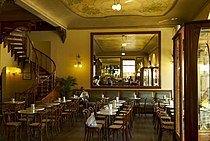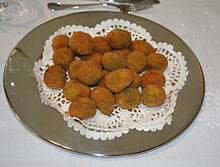Ascoli Piceno
| Ascoli Piceno | ||
|---|---|---|

|
|
|
| Country | Italy | |
| region | Brands | |
| province | Ascoli Piceno (AP) | |
| Coordinates | 42 ° 51 ' N , 13 ° 35' E | |
| height | 154 m slm | |
| surface | 160 km² | |
| Residents | 47,555 (Dec 31, 2019) | |
| Population density | 297 inhabitants / km² | |
| Post Code | 63100 | |
| prefix | 0736 | |
| ISTAT number | 044007 | |
| Popular name | Ascolani | |
| Patron saint | Sant'Emidio (Emygdius of Ascoli) | |
| Website | Ascoli Piceno | |
 Ascoli Piceno's cathedral in front of Monte Ascensione |
||
Ascoli Piceno is an Italian city with 47,555 inhabitants (as of December 31, 2019) in the Marche region . In ancient times it was called Asculum. The current name is traced back to the Iron Age tribe of the Picenos , whose capital it is said to have been, or to a mysterious woodpecker ritual ( Picchio in Italian : woodpecker) of the Sabines, for example by Strabo and Pliny the Younger.
geography
Ascoli Piceno, capital of the province of Ascoli Piceno , is located in the south of the Italian region of Marche. The place is surrounded by three mighty mountain sticks and lies 30 km inland from the Adriatic coast at an altitude of 154 m slm
The districts include Bivio Giustimana, Campolungo, Caprignano, Carpineto, Casa circondariale, Casalena, Casamurana, Case di Cioccio, Casette, Castel di Lama stazione, Castel Trosino, Cervara, Colle, Colle San Marco, Colloto, Colonna, Colonnata, Faiano, Funti, Giustimana, Il Palazzo, Lago, Lisciano, Lisciano di Colloto, Montadamo, Morignano, Mozzano, Oleificio Panichi, Palombare, Pedana, Piagge, Pianaccerro, Poggio di Bretta, Polesio, Ponte Pedana, Porchiano, Rosara, San Pietro, Santa Maria a Corte, Talvacchia, Taverna di mezzo, Trivigliano-Villa Pagani, Tronzano, Valle Fiorana, Valle Senzana, Valli, Vena piccola, Venagrande and Villa Sant'Antonio .
Culture and sights
The Dom Sant'Emidio on the Piazza Arringo (also known as Piazza dell'Arengo ), the cathedral of the Ascoli Piceno diocese , was originally a Romanesque building that was rebuilt several times. Right next to the cathedral is the early Romanesque baptistery , an octagonal building. In the piazza is also the town hall, the Palazzo Comunale (1683-1745), which houses the city art museum Pinacoteca civica , with works by Cola dell'Amatrice, Crivelli and Tizian , among others . Not far from there is the Romanesque church of San Gregorio Magno , in which you can still see the remains of a Roman temple (1st century BC).
Nearby is the center of the city, the Piazza del Popolo (People's Square), which in fact it is for the Ascolans. The Palazzo dei Capitani del Popolo from the 13th century and the Gothic hall church of San Francesco (1258–1371) are located here. Attached to the right side of "San Francesco" the Loggia dei Mercanti , the market hall (1513), left the Renaissance - the cloister , in the morning takes place in the market. In the toilets of the Art Nouveau coffee house "Caffè Meletti" you can find remains of walls from Roman times under the (transparent) washbasins.
The caffè was also the location of the films Dangerous Nights , Alfredo, Alfredo and The Great Blek .
Further sights are the Roman bridges Ponte di Cecco and Ponte Romano di Solestà , the latter with a wonderful view over the old town and the river; the Romanesque church of Santi Vincenzo ed Anastasio (11th century) with 64 square fields on the facade, the church of San Pietro Martire and the Teatro Ventidio Basso , built in 1840–1846 .
On and on the Piazza Santa Maria Inter Vineas , named after the Chiesa Santa Maria Inter Vineas on its north side, the novel L'amore negato (“The denied love”; published in Maja Pflug's translation under the title Every loneliness is different) is set ) by Maria Messina .
Closer surroundings
Two kilometers south of the city there is a small Roman bridge over the Gran Caso .
The Quintana
The Ascoli horse show, the " Giostra della Quintana ", dates back to the Middle Ages (first mentioned in the town statutes of 1377). It takes place annually on the first Sunday in August.
Similar to the Landshut wedding , it follows a fixed ritual in which large parts of the residents present themselves in historically true medieval clothing, around 1500 alone take part in the morning parades. The actual competition on horseback, the quintana, is stabbing with a lance. The representatives of the six districts gallop along a course in the shape of an eight, in the middle of which there is the oversized figure of a Saracen . Whoever rides the fastest and meets the Sarazzen best wins. This ritual is reminiscent of the Saracens, who tried unsuccessfully to conquer Italy several times in the Middle Ages. In the evening, various festivals take place in all parts of the city.
Culinary specialties
The Oliva Tenera Ascolana is famous for its size and taste and was already appreciated by the Romans. The "Olive all'ascolana" ( Ascolana style olives ) are breaded and fried olives of the "Ascolana Tenerife" style filled with meat.
Twin cities
There has been a town twinning with Massy in France since 1997, signed by Mayor Roberto Allevi for Ascoli Piceno and by Mayor Vincent Delahaye for Massy. There has also been a city partnership with Trier in Germany since August 31, 1958.
Sons and daughters of the church
- Sextus Iulius Caesar (* before 130 BC; † 90 or 89 BC), politician of the late Roman Republic and probably the uncle of Gaius Iulius Caesar
- Nicholas IV. (1227–1292), Pope from 1288 until his death
- Giacinto Cornacchioli (1599–1673), composer, singer and organist
- Giovanna Garzoni (1600–1670), painter
- Antonio Orsini (1788–1870), natural scientist and patriot
- Filippo de Angelis (1792–1877), bishop and cardinal
- Giuseppe Angelini (1810–1876), Curia Bishop and Auxiliary Bishop in the Diocese of Rome
- Antonio Sabatucci (1835–1920), Archbishop and Diplomat of the Holy See
- Angelo Ruffini (1864–1929), doctor, university professor for anatomy, embryology and physiology
- Giuseppe Renzetti (1891, 1893 or 1896–1953) Liaison between Benito Mussolini and Adolf Hitler in the 1920s and early 1930s
- Fernando Tambroni (1901–1963), 1960 Prime Minister of Italy
- Giuseppe Petrocchi (* 1948), Cardinal, Archbishop of L'Aquila
- Giuseppe Piccioni (* 1953), film director and screenwriter
- Stefano Russo (* 1961), General Secretary of the Italian Bishops' Conference, Bishop Emeritus of Fabriano-Matelica
- Vincenzo Ceci (* 1964), track cyclist
- Giuseppe Iachini (* 1964), football player and coach
- Massimiliano Narducci (born 1964), tennis player
- Simone Vagnozzi (* 1983), tennis player
- Luca Ceci (* 1988), racing cyclist
- Francesco Ceci (* 1989), racing cyclist
- Mattia Destro (* 1991), soccer player
- Romano Fenati (* 1996), motorcycle racer
Web links
- Newspaper article about the Quintana
- La Quintana di Ascoli Piceno , information about the Quintana (English and Italian)
Individual evidence
- ↑ Statistiche demografiche ISTAT. Monthly population statistics of the Istituto Nazionale di Statistica , as of December 31 of 2019.
- ↑ Emygdius or Emidius on heiligenlexikon.de











